This biography is in a different format to most of our others as it concentrates on a photographic CUSTOMER and what he did with his photographs in times, both good and bad.
The article was first published in a shortened form in Photographica World, the magazine of the Photographic Collectors Club of Great Britain and is available on this website as a Free Download. For more details about the Photographic Collectors Club of Great Britain, please visit http://www.pccgb.com
The Diaries of Charles Johnstone – 1849 to 1884
A family history researcher, James Robertson from Anglesey, on a quest to find out more about his father’s mother’s family, tracked down the Victorian diaries of his great grandfather, Charles Johnston(e) in County Down.
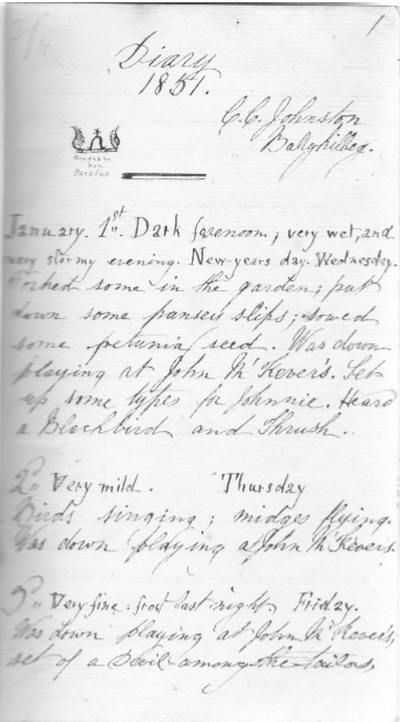
The set of diaries starts in June 1849, just after Charles’ 14th birthday, and continues until 1884 when he was 49 years old – a period of 35 years. Charles died in 1913 at the age of 78 but any diaries he may have kept after 1884 are missing.
The life the diaries describe is cultured, uninhibited and unconventional. After completing his studies in Dublin and after the early death of his parents when he was just 17, he acted as land agent for his brother William, who inherited the family estate in Lecale, County Down in Ireland.
In 1863 he came into money when his grandmother, who lived in Stirling in Scotland, died and this allowed him to set up his ‘gentleman’s residence’ near his brother’s estate, close to Downpatrick. He joined the South Down Militia, which gave him a very part-time job. He enjoyed parties and drink, worked hard in the interests of family and friends, but devoted most of his energy to his family and to affairs of the heart. He established mistresses at various addresses and had to maintain a web of deception concerning his whereabouts and liaisons. He was constantly on the move, at one time having three establishments in Scotland and one in Belfast, which required him to take the boat between Scotland and Ireland monthly.
The childhood diaries were written in notebooks, with illustrations and secret codes which added to their charm. As an adult he used Lett’s diaries, latterly filling the bulky Lett’s No 8. The 1884 diary runs to 42,000 words, the length of half a novel. From childhood onwards he maintained the habit of adding in the weather for the day at the beginning of each entry, thus providing a useful 19th century weather record. He also recorded meteorological information such as sightings of comets and the aurora borealis. The farming practices of the time were described, down to the many varieties of potatoes grown, from Ballygawley Pinks to Hen’s Eggs. Transport played a large part in his life and he witnessed the arrival of two new railway lines in County Down and new lines opening in Scotland. Political conflict, crime, illness and death are among the themes which give the diaries their historical interest.
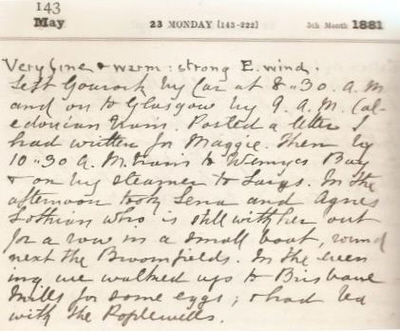
This article deals with entries related to photography, some with additional notes about the photographers involved and the way that Victorian customers used the images that they commissioned.
The diaries mention visits to various photographers and reveal what Charles did with some of the portraits that he so treasured. A nice record of social history and a really interesting spotlight on how photography affected at least one Victorian gentleman.
Here is a humorous photograph of Charles (Charlie) Johnstone, probably taken in 1864 by Brown & Dunlop, in Falkirk.
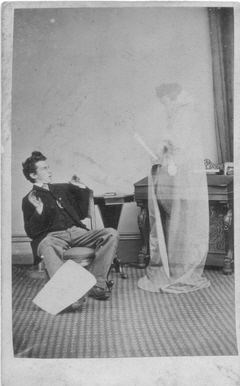
‘Ghost’ pictures were uncommon and were usually produced as a form of humour. To do this, the photographer took more than one exposure on the same glass plate.
As it appears that Charles and the ghost were the same person, in this case, the right half of the lens was left covered and a full exposure taken through the left half only. The lens was then covered entirely whilst the subject was dressed as a ghost and moved to the right hand side of the picture. Then the left half of the lens was covered and the right half only was exposed for a half exposure with the ‘ghost’ in the shot. The whole lens was then covered entirely again whilst the ‘ghost’ left the scene. Finally the right half only of the lens was exposed again for another half exposure.
The Diaries
15th September 1852: “Got a sixpenny likeness of myself in Falkirk”
At this time Charles was just 17 years old.
There is every likelihood that the ‘sixpenny likeness’ was not a photograph but a silhouette which was either painted or alternatively cut from black paper with scissors. Mr. Seville’s advert of 1838 states a charge of just six pence.
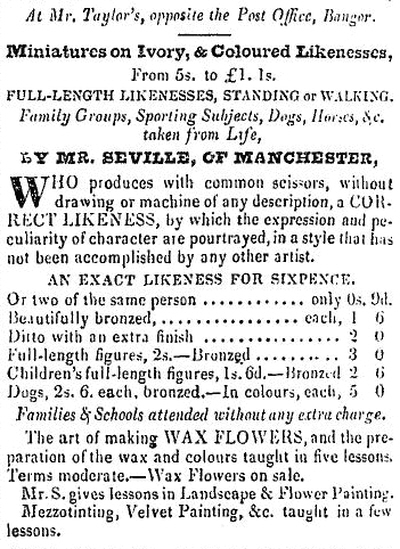
A further advertisement from the same man from 1850 offered a similar product.
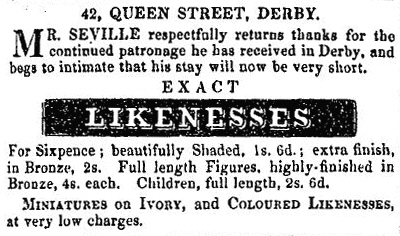
By 1855 an advert, also from the same person, related to PHOTOGRAPHIC portraits but the minimum price was two shillings.

These photographic portraits were produced as weak negatives on glass but, when backed with a dark material or black paint, they appeared as normal positive images: these were ambrotypes.
Photography started in 1839 but at that time was really in the hands of a few scientists, professionals or wealthy amateurs. Not many family photographs exist from that era unless they are beautiful images on a polished silver plate (that looked like a mirror). These are daguerreotypes as invented by Louis Daguerre in France.
Up to this stage, photos were generally one-offs, there was no negative and multiple copies were impracticable. Any copies required had to be photographed from the original – often with a distinct loss of quality.
Both ambrotypes and daguerreotypes can be found in maroon ‘leather’ cases or highly ornate Union Cases made from a shiny and brittle thermoplastic material.
The popular carte de visite format was not yet readily available in 1855 as it became popular only in 1860.
9th April 1856: “I went down to Belfast…Got a photograph of myself taken.”
11th April 1856: “Gave Maggie Taylor the locket, Church Service and photograph.”
6th May 1856: “Went down to Belfast, got a photograph likeness of myself for Grandmother and a pin with my hair for Grandpapa, and a parcel of other presents to give on my birthday.”
Charles was 21 years old just eight days later on the 14th May 1856 and he was still living in the family home in County Down which his brother William had inherited after the early death of his father in 1853. His grandparents lived in Stirling in Scotland.
Pins for neck ties, cravats etc. were common male items so this may have been what he bought, with some of his hair as part of the pin. Hair was a common element of Victorian jewellery and it is believed that Charlie had striking red hair.
Charlie was a generous present-giver but giving presents on one’s 21st birthday was probably not a usual practice. He sent a parcel to his grandparents with the presents.
Here is his entry for his birthday: 14th May 1856: “Wednesday. Rainy. This is my twenty-first birthday. Gave William a new side-board, and to Haddie a silver flower stand for the centre of the table, other presents for the rest. Got a ring with the crest from William and Haddie and other presents from the rest. Got the dining room and drawing room laid out for a party. Had for dinner besides ourselves – Rachel and Lizzie Cumming, Mr. Fallon and Bobbie Matthews. Had a great display of fireworks in the evening; had singing and some little dancing.”
Again, the type of photograph mentioned would most likely have been an ambrotype. See an example below:
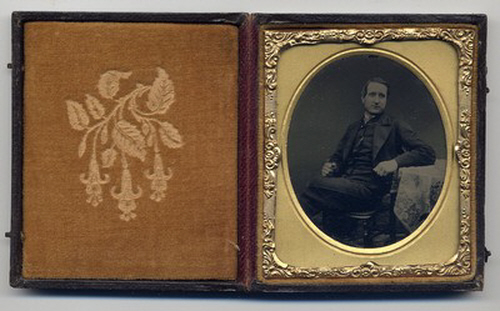
Ambrotype open (above) & closed (below) – both reduced in size
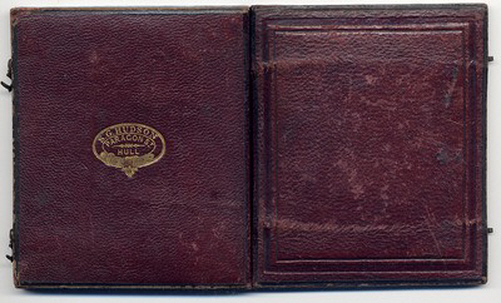
15th June 1856: “Was with Maggie Taylor till evening, she gave me a photograph of herself which she got taken in Belfast on Wednesday.”
23rd May 1857: “Walter Lang took me down to his brother John’s house [in Kirkcaldy] to see him take some photographs.”
25th May 1857: “Was up in Lang’s nursery. Went up to the path head with Walter [Lang] and his father to see William Saunderson; he [Lang] has taken to photographing and his flowers are all gone to pot.”
By this time Charles was just 22 years old and was staying in Kirkcaldy. He accompanied his grandparents on a visit to see family friends, the Langs, who ran a nursery. The following year he comments on a letter he received in French from one of the Langs, accompanied by slips of prostrate Scot’s pine.
It is likely that Lang was a keen amateur photographer, though there were very few amateur photographers about at that time.
7th November 1857: “Went into Down. [Downpatrick] Got a photograph of myself taken, also one of Robert Hunter and James Doonagan together. There are two photograph establishments there just now.”
To date, no record has been found of any studios in Downpatrick at that time. It is possible that at least one of the photographers was an itinerant.
12th November 1857: “Got two more photographs taken by Waites. Sat for one for Nash, at Mrs. Waring’s, to put in his case.”
17th November 1857: “Had Waites and Hildyard out to take photographs but the day turned out unfavourable.”
There is no record of a photographer called Waites around that time but there was a Walter Hildyard who opened a studio in Manchester in 1861.
20th November 1857: “Had the photographers out again taking portraits and views.
21st November 1857: “Got the photographs all finished.”
22nd February 1858: “Went to meet Susan Jane Cullen at the wee planting at Kane’s Bog. Gave her my likeness. She is going to Belfast to school on Monday.”
Charles was 22 years old at this time – why would he be giving his likeness to a young lady? Perhaps because images were a way of keeping the subject alive in the mind of a potential lover.
26th May 1858: “Showed Walter Lang the photographs I brought of the house.”
28th May 1858: “Bought two stereoscopic views of Kirkcaldy; gave them to Grandmother.”
In his accounts Charles records that he paid 3/- for the stereoscopic views he bought on 28th May. A very approximate cost today might be £15.
26th June 1858: “Got two stereoscopic photographs – negatives – taken of myself, by Douglas in Lough’s Nursery, sitting on a rustic chair and with a stuffed deer beside me.”
Charles was in Kirkcaldy again at this stage on a visit. The only professional photographer to advertise his wares in Kirkcaldy named Douglas was Robert Douglas at 9 Kirk Wynd. Although his first advertisement in the trade directories did not appear until four years later in 1862, he had probably started taking photographs at other locations, or possibly had a studio but did not advertise and therefore he did not appear in trade directories in 1858.
Stereoscopic images were not uncommon in the late 1850s but they were usually of scenery rather than portraits of people.
28th June 1858: “Got the plates of my photographs from Douglas”
29th June 1858: “Gave one of my stereoscopic photographs to Walter Lang.”
18th October 1858: “Got a package of a dozen photograph slides for the stereoscope views about Kirkcaldy.”
The next day he wrote to Douglas thanking him for the slides, which cost 9/- (say £45, about £3.75 each at 2017 values). Stereoscopic images were very popular at this time and many photographers took pictures of local views and sold them in large quantities – rather like the postcards that followed several decades later. Below is an example by the famous firm of G W Wilson & Co.
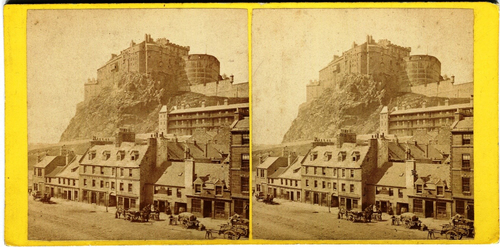
Stereograph of Edinburgh by G W Wilson & Co
16th February 1859: “Rosina gave me her photograph.”
23rd April 1861: “Went into Stirling. Got three photographs at Crowe’s.”
Charles was now nearly twenty-seven years old.
Alexander Crowe had started to advertise his studio at 33 Murray Place, Stirling in 1859. He was still there in 1861 and remained until 1871 when he went into partnership with a Mr. Rodgers.
This is a photograph which is of (not by) Alexander Crowe taken some time after 1871.
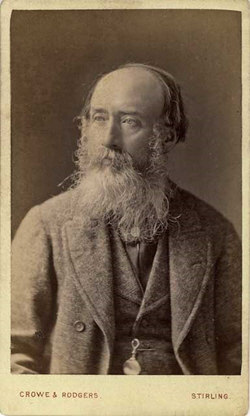
Produced by kind permission of Peter Stubbs at www.edinphoto.org.uk
24th April 1861: “Went into Stirling. Got my photographs at Crowe’s.”
4th April 1863: “William and Ina Hay were married today in St. John’s church. [Dublin] I was best man. The bridesmaids all went off to be photographed at Armstrong’s.”
In those days the wedding party went to the photographer instead of the photographer going to the church. Below is a typical photograph of a well to do bridesmaid from the early 1860s -in this case taken by Herbert Watkins in London.
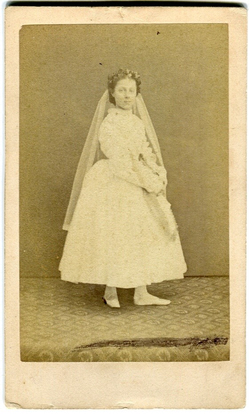 |
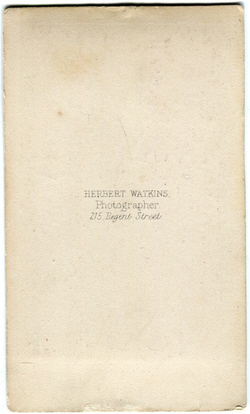 |
Tuesday 5th May 1863: “Got cartes taken at Ross & Thompson, Edinburgh.”
Charles is referring here to the carte de visite photograph that burst into popularity in 1860. James Ross & John Thompson operated one of the leading studios in Edinburgh at the time and were at 90 Princes Street from 1848 to 1864. They had other studios in Edinburgh during that period and the partnership was transferred to John Ross alone in 1864. Here is an example of the partnership’s work from 1864.
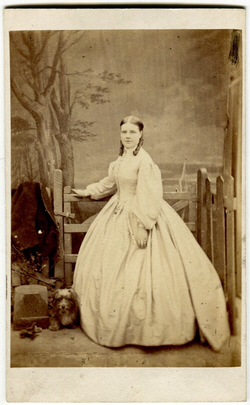 |
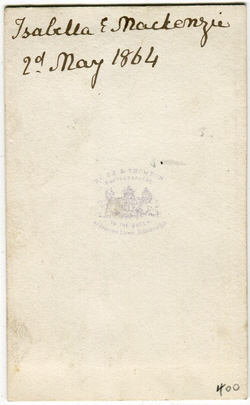 |
Example of a carte de visite by Ross & Thompson 1864
By the 21st century, 90 Princes Street has changed somewhat – courtesy of Google StreetView.
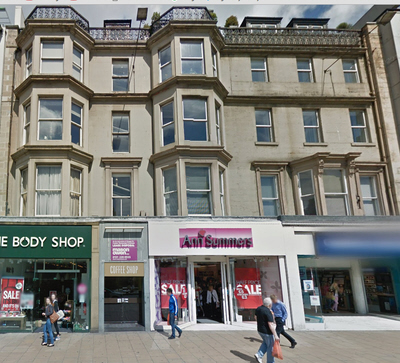
29th May 1865: “Began to make my new album with photography and decalcomanie pictures.”
Décalcomanie is a decorative technique by which engravings and prints are transferred to pottery or other materials.
8th January 1867: “Received a photograph of Elviston Castle from Johnnie.”[brother]
21st April 1867: “Sent some photographs to Eddie, Lillie and Charlie.” [children]
17th September 1867: “Maud Murray gave me her carte.”
12th December 1867: “Sent my own carte and Edward Eagar’s to Mary Cumming on the [S S] Great Britain.”
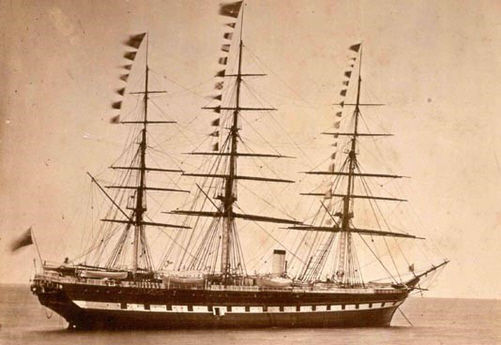
S S Great Britain in the 1860s
5th May 1868: “Lizzie gave me one of her new cartes, it is a very good one.”
Wednesday 30th September 1868: “Kate & I went & had our cartes taken at Ralstons 195 and a half Argyll Street – myself standing & one of her sitting & another standing with hat & jacket on.”
Charles was now thirty three years old.
This was a studio in Glasgow run by Peter Ralston. According to trade directories it appears to have been advertised as ‘Ralstons’ only in 1868 although the studio was there from 1858 to 1874. There were several other studios run by the Ralston family in Glasgow around that time. It was usual to have a few photographs taken at a session with the subjects posed in different ways, in this case standing, sitting and with different clothes such as coats and hats.
Below is an example of the type of carte de visite taken by Ralstons in the same period in the mid/late 1860s.
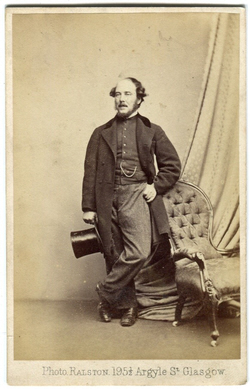
An example of a Ralstons carte de visite taken in the mid/late 1860s
5th October 1868: “Got the cartes of Kate & myself; mine is very like & also the sitting one of Kate.”
6th October 1868: “Bought another six of my cartes.”
Photographers made a good profit out of providing extra copies at the time of the first order or, sometimes, many years later.
10th October 1868: “Wrote to Mannie, enclosing one of my cartes.”
16th October 1868: “Tinted the faces of two cartes of Kate.”
It is interesting that, in this case, the customer has tinted the photograph rather than having it done professionally by the photographer.
19th October 1868: “Called at the Post Office and got six cartes sent there from Glasgow.”
13th March 1869: “Got three cartes of William at Marcus Ward’s.”
Marcus Ward & Co was a leading photographer in Belfast and had a studio at 13 Donegall Place, High Street, Belfast from 1865 to 1870.
16th March 1869: “Wrote to Kate sending carte of William for Miss Story.”
22nd March 1869: “Went into Belfast, got three cartes of William – vignettes.”
Vignetting was starting to become popular at this time. It consisted of producing a photograph in the style of a vignette by softening or shading away the edges of the subject. Below is an example of a vignette style carte de visite by the same photographer, Marcus Ward & Co, in 1867. It is of the actor Barry Sullivan.
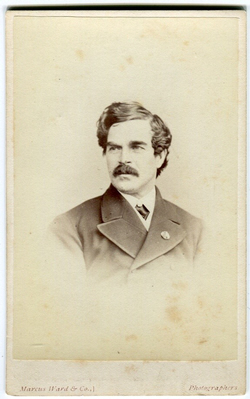 |
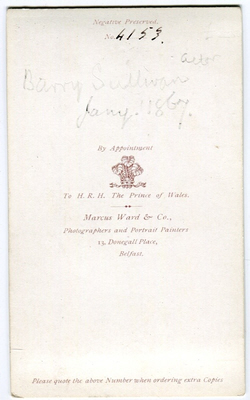 |
Vignette carte de visite by Marcus Ward & Co
25th July 1869: “Heard from Rosina, enclosing a carte of herself and her husband.”
26th July 1869: “Met Mr. Nickle, showed him the carte of the Kerrs.”
10th January 1870: “Left my photograph of Gibraltar at Burkes to be mounted and framed.”
Although many photographers offered a picture framing service, Burke’s does not appear to be a photographer as well as a framer.
22nd February 1870: “Went into a shop and brought home some photographs.”
1st March 1870: “Went up to Pesa where we bought a lot of photographs.” [in the port at Constantinople]
11th April 1870: “Took over my photographs to show them.” [Messrs Forde, Parsons, Eagar and Gordon in County Down]
25th April 1870: “Left my photographs of Constantinople to be framed at Burke’s on Aston Quay”. [Dublin]
8th June 1870: “Heard from Kate and Rosina enclosing a carte of herself, not at all good.”
Friday 24th June 1870: “Called to see the proofs of some cartes of the children at Church’s in Donegal Place”
The children referred to were Charlie’s children by Maggie McKever; Eddie, Lillie, Charlie and Edith.
The studio of Edmund T Church, at that time, was at 53 Donegall Place and was one of the high quality outfits operating in Belfast, County Antrim in the north of Ireland. It operated there from 1869 to 1890. The firm also incorporated 55 Donegall Place from 1871 to 1876.
It was part of the usual process to have the photographs taken and then pop in to look at the proofs before ordering the final prints.
Interestingly, Charles Johnstone visited the same studio again three years later in 1873 to have the portraits copied; or for more images to be produced from the original negatives.
Here is an example of E T Church’s work taken at the 53 Donegall Place studio.
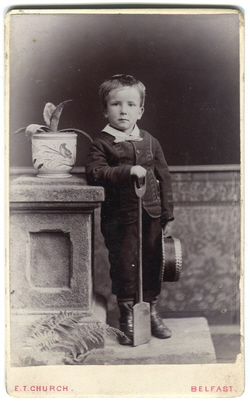 |
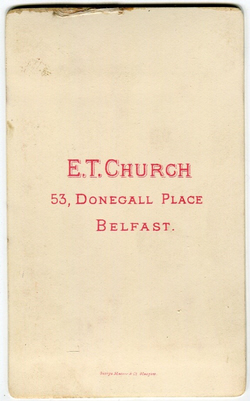 |
An example of a cdv of a young boy by E T Church, 53 Donegall Place, Belfast
26th June 1870: “Wrote to Ralston photographers Argyll Street, Glasgow to enquire if they still had the negatives of Kate’s and my cartes taken in October 1868.”
See the previous entry dated 30th September 1868.
30th June 1870: “Wrote to Ralston, photographers, Glasgow, enclosing 5/- postage stamps to get six of my cartes and six of Kate’s. Bought a little book of photographs of Dunkeld.”
It is interesting to note the price of 5/- for 12 reprints which is paid for in postage stamps. Five shillings in 1870 is equivalent to about £27 in 2017.
2nd July 1870: “Got Kate’s and my cartes from Ralston in Glasgow, six of each.”
9th July 1870: “Sent a little book of Dunkeld photographs to Kate.”
5th October 1870: “Left my photograph of Gibraltar at Burke’s to be mounted and framed.”
7th July1871: “Called and saw photographs of the regiment at Lawrence’s.” [Dublin]
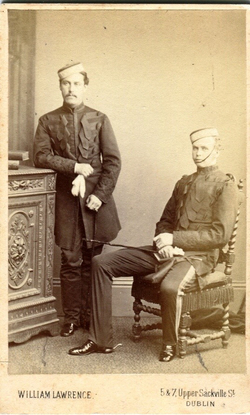 |
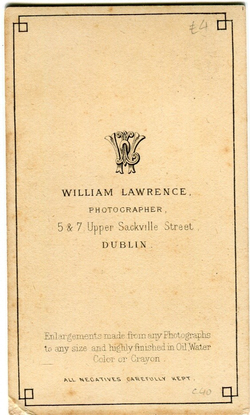 |
A military carte de visite by William Lawrence of Dublin
William Lawrence was a leading photographer in Dublin’s main street – Upper Sackville Street (now O’Connell Street) – from 1867 until at least 1892.
He took photographs of men in uniform as well as the usual type of family portrait.
23rd September 1871: “Found a lot of letters [including] one from Margaret Rooney enclosing a carte for Jessie.” [his daughter by servant Bella Rooney]
1872: Unfortunately the diary for 1872 is missing.
31st March 1873: “Called at Church’s photographer, and left two of my cartes to be copied.” [this is Edmund T Church in Belfast]
3rd May 1873: “Sent the die of the coat of arms to Archer, Belfast, to put it on the new photograph album.”
5th December 1873: “Saw, by a fluke, a photograph of Lizzie taken in the Isle of Wight at Ryde, with a baby on her knee!!” [His sister-in-law]
27th December 1873: “Wrote to Arthur Debenham, photographer, Ryde, for two cartes of Lizzie.”
The Debenham family was very extensively involved in the photographic business and had nearly 100 studios in various towns, mainly in the southern part of England and on the Isle of Wight.
31st December 1873: “Walked into town; [Dublin] called at Carty’s, and put a ring to my locket with poor wee Billy’s likeness.”
13th August 1874: “Wrote to Dr Vesey sending him 1s 6d in stamps for photo of Regiment.”
There are nine references to Dr. Vesey in the 1879 diary, and on one occasion Charles visited him at home in Rhostrevor. Their relationship (and his photography) was based on the South Down Militia connection. Dr. Vesey appears to have been an amateur photographer. There was a photographer called Vesey in London at that time but the diary reference was not related to him.
16th August 1874: “Heard from Vesey with a photo of part of the Camp, officers tents.”
7th September 1874: “Heard from Dr Vesey with photos of camp.”
7th December 1874: “Left the photo of old Robert Hunter and Dunagan at Mack’s in York Street to get cartes of Robert taken for his daughter Catherine.”
This was a common practice to buy extra copies of photographs for friends and relatives.
24th December 1874: “Got cartes of old Robert Hunter from Mack”
The family left Dublin in 1874, moving at first to Glasgow, and spending the summer at Innellan, and in May 1875 moving to Church Hill Cottage, Duddingston, a quiet backwater outside the city, on the far side of Duddingston Loch.
3rd March 1875: “Called at Mack’s photographer [Belfast] and got my original photograph of Robert Hunter and Doonegan.”
John Mack advertised as a photographer in 1870 in Coleraine in County Londonderry but by 1875 he had obviously moved south to 84 York Street, Belfast in County Antrim as there would have been many more potential customers. He definitely advertised in Belfast from 1877 to 1890. By 1894 he had returned to Coleraine and re-opened a studio there. Here is an example of his portraiture in the mid/late 1870s.
Here is an example of E T Church’s work taken at the 53 Donegall Place studio.
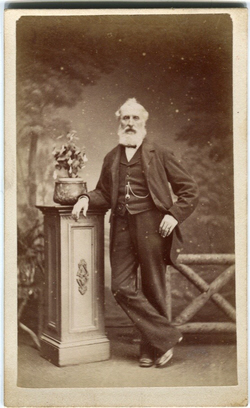 |
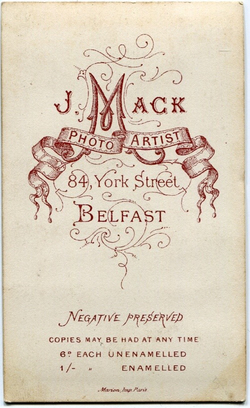 |
Carte de visite portrait by John Mack mid/late 1870s
16th April 1875: “Walked with Maggie up Sauchiehall Street [Glasgow] to Ralton’s to see about getting Walter and Flora photographed”.
Saturday 22nd May 1875: “We all went down to Portobello where we got photos taken at Kyles of Walter and Flora together and Walter alone, also Maggie alone, and then with Eddie and Lillie in the costume of a Newhaven Fishwife.”
Charles, at the age of 40, was writing up increasingly detailed diaries, reflecting the complexity of his life. In this year his diary runs to more than 36,000 words.
William Kyles was a prolific photographer in Edinburgh with studios in Bath Street, Portobello from 1865 to 1877. Prior to that time he was in partnership with James L Law t/a Kyles & Law and in 1877 he went into partnership with a William S Moir t/a Kyles & Moir.
Here is an example of a lady dressed as a fishwife and taken by Kyles in Portobello.
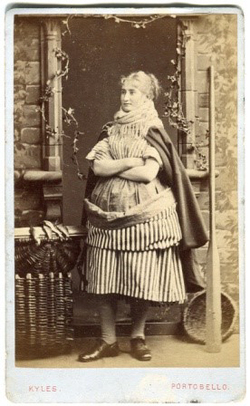 |
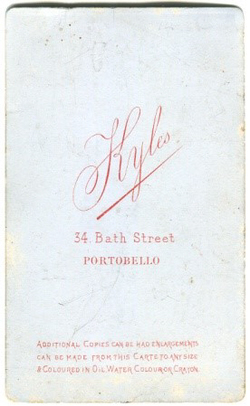 |
Carte de visite of a fishwife taken by Kyles of Portobello, Edinburgh
This was a particular speciality of William Kyle and his various partners. Customers were offered the opportunity to use studio props to dress as fishwives in areas where the fishing industry was particularly important. Many fishwife photographs were of genuine local fishwives who were paid to pose so that the photographer could duplicate the images and sell them to visiting tourists – this is especially so when images started to be produced in the postcard format around the turn of the century.
Peter Stubbs, on his excellent website http://www.edinphoto.org.uk says “Several Edinburgh photographic studios had costumes allowing their clients to dress as fishwives.” Here is an 1895 advert relating to the same service.
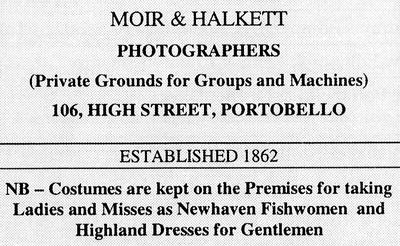
Produced by kind permission of Peter Stubbs at www.edinphoto.org.uk
Here is a later postcard view of Bath Street where Kyles had had his studio.
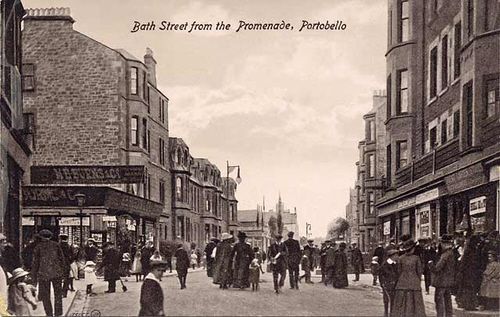
Produced by kind permission of Peter Stubbs at www.edinphoto.org.uk
7th June 1875: “Drove with Dick Nelson and brought Maud [Lambert] and Nannie Severs to camp where they remained and drank champagne till after six. Lord Newry took two photographs of us.”
Lord Newry appears to have been a keen amateur photographer according to the quote from the novel ‘ The Looking Glass House’ by Vanessa Tait. It says” Lord Newry’s ball, might lift one’s spirits significantly. … said Lord Newry. … He stood up from the wheelbarrow that he was filling with his photographic apparatus”
On the 1st. November 1875 Charlie moved his family from Duddingston, to Grange, a more convenient location across the Meadows from the heart of Edinburgh. They moved into a substantial Victorian villa at 20 Dick Place.
4th March1876: “Wrote to Lizzie, returning the one of Jackie’s cartes which I did not care for.”
8th April 1876: “Heard from Eliza Forster, enclosing one of Hardy’s cartes.”
20th May 1876: “Nine copies of poor Wassie’s carte came from Kyles, from Portobello. It will be just a year on Monday since it was taken, oh dear! Oh dear!”
22nd June 1876: “Went into town by tramway and down to Portobello by 3 p.m. train and ordered two enlarged photos of my dear wee Wassie at Kyles.”
The portrait, shown below, is a very touching memorial to a greatly loved small boy, whose hand-coloured photo is in a black frame with crosses on all four corners [often known as an Oxford frame].
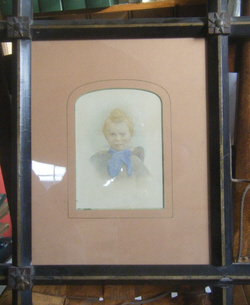 |
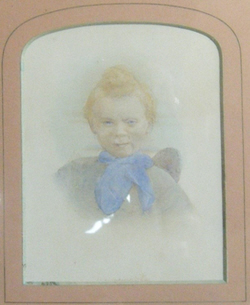 |
When the picture was cleaned in 2015, the backing board and a sheet of newspaper were found; it was dated November 1877. The diaries include an entry on 22nd November 1877 as follows “Maggie & I went out in the middle of the day, down to Patrick Street & ordered some porter; also ordered two frames at the German shop, for the two cabinet-size pictures of my darling I have got for Ballydugan.” Charles brought the frames back on 29th November 1877 and took them to Ballydugan (where he had his ‘gentleman’s residence’) on 3rd December 1877.
The framed photograph above came to family researcher James Robertson via the family home in Lecale, County Down. The main points of interest are the German shop, that they are cabinet-sized and that Charles seems to have done the framing (& colouring) himself.
26th June 1876: “Left one of [Wassie’s] cartes at Lunny’s to be coloured.”
27th June 1876: “Called at Lunny’s but the photo was not coloured. Drove to Waverly station and left my luggage and then down to Portobello by 4.40 train and called at Kyles to see the enlarged photos of my darling but did not see them.”
28th June 1876: “Lena went on into Edinburgh, but I got out at Portabello and called at Kyles to see the photo proofs and then on by tramway.”
Tuesday 25th July 1876: “Grant and I had our cartes photographed in full dress at Churches’ in the morning before parade.
By this time, Charles was 41 years old. Grant was a fellow officer in the South Down Militia and was on training exercises in Kildare.
J F Church had a studio at the Curragh Camp in Kildare and he would have taken many pictures of soldiers and their families. Studio operating dates are often picked up from advertisements in trade directories but Church does not appear to have advertised. This is not surprising as he had a captive market. He was definitely there between 1874 and 1876 but almost certainly for several years outside of those dates as well.
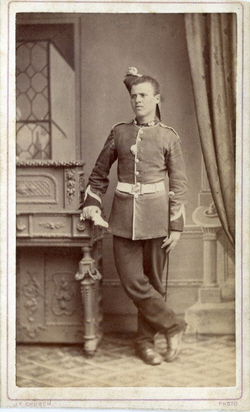 |
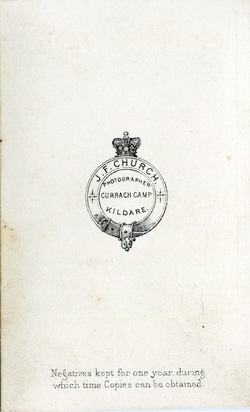 |
A carte de visite photograph of a soldier from Curragh Camp
Saturday 12th August 1876: “Extremely fine & warm. Wrote to Church, photographer at the Curragh, ordering ten more copies of my cartes taken in uniform; also to Kyles, photographer, sending a lock of darling Wassie’s hair.”
Monday 16th October 1876: “Got back from ‘school’ about 2am having given GAP (his mistress Georgina Alexina Peppard) the photo case I bought her from Edinburgh.”
Tuesday 9th January 1877: “Called at Kyles, and ordered an enlarged photo of Maggie and wee Wassie as a baby; also another of darling’s wee face, medium size.”
Saturday 27th January 1877: “Went on to Kyles & Moir; & brought back proof copy of Maggie & wee Wassie as a baby enlarged; and also carte of vignette of my dear, enlarged.”
This was the same studio that the family visited in 1875 when it was run by William Kyles. It was now operated by the partnership of Kyles & Moir.
Saturday 10th March 1877: “Went to Kyles & saw the enlarged colored [sic] photo of Maggie & dear wee ‘Bap’ & chose a frame for it; also some other enlarged ones of my wee darling’s head.”
28th March 1877: “Tried the coloring [sic] of one of the enlarged photos of my darling, but did not succeed very well, so I sponged it off again. Was out to the post. Wrote to Mrs Orson, sending her one of the vignette cartes, of my darling.”
When required, it was usual to have the photographer, or his colourist, add colour to a photograph especially if it was a costly enlargement. Enlargements were coloured professionally with oils, pencil or even with pastel chalks. It was most unusual for a customer to add colour and sponging it off would seem to be potentially injurious to the image.
Tuesday 10th April 1877: “Rain, sleet & snow in forenoon: dull, dark afternoon. Went out & bought a lot of little frames for photographs.”
10th July 1877: “Called at Robinson’s [stonemason, Belfast] about wee Jaspar’s head stone, it is finished but not set up yet; called at Mack’s to see photo of it, but did not like it, as he has merely done it in front and not showing the shape of the stone. He is to do another.”
15th August 1877: “Wrote to Church, photographer at the Curragh, for six of my cartes.”
Later Charles records that he paid 3/- for them.
17th Sept 1877: “Went up to the Cemetery [the Grange, Edinburgh] after breakfast, washed and cleaned my darling’s monument, [to Walter] and blackened the letters with Indian ink where they were growing white. Kyles came at half past ten from Portobello and took two photographs of it; he admired it very much.”
Here is a modern photograph of little Walter’s head stone. The broken column symbolises a life cut short, and the dove on the left-hand side of the column symbolises purity and love.
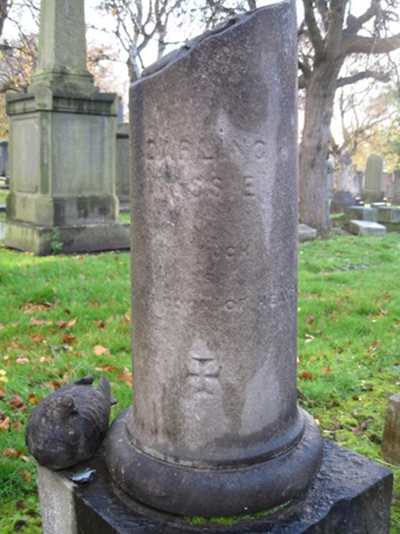
2nd January 1878: “Re-arranged my photograph album.”
Saturday 23rd March 1878: “Started with Maggie & the four children, & walked to Portobello by the Park; we went to Kyles & Moirs, and got cartes taken of Lillie alone, Charlie & Edith standing together, Flora standing & sitting, Maggie standing, two positions & myself standing & vignette. Moir did them, as Kyles has left & gone to Dundee.”
The studio was still at 34 Bath Street, Portobello, Edinburgh in business under the partnership name of Kyles & Moir and remained so through until 1882. The comment ‘gone to Dundee’ may well refer to a personal visit only as there is no record of Kyles working as a photographer in Dundee. He did, however, open a studio in his own name at 29 Newmarket Street, Ayr by 1880.
Saturday 27th April 1878: “We went to Kyles & Moir’s & ordered copies of cartes of myself & the children, last taken. Paid old account. Maggie got taken, three positions again, on trial, and I got taken with the Turkish fez on.”
Another trip as was usual to select and order the prints that were required. The Turkish fez is not something that is commonly seen on cartes de visite; was this anything to do with Charles’ trip to Constantinople in 1879 maybe? Most photographers kept interesting accessories for their grown up customers as well as various toys for use when taking children – it often helped the youngsters to relax and usually resulted in a more acceptable likeness.
28th September 1878: “We drove down to Portobello where Lewie [Lewis Hay, his nephew] got photographed at Kyles and Moir’s in Bath Street.”
25th June 1879: “Vesey took a few photos [of South Down Militia Inspection Day parade in Downpatrick] and left.”
23rd June 1880: “Got proofs of photos from Maggie.”
24th June.1880: “The cabinet-sized photo of Maggie is the best ever done.”
Maggie was living in Edinburgh and almost certainly using Kyles, Portobello.
3rd April 1881: The census date.
The 1881 census records the household as follows: Charles Johnstone, army officer, 45, Margaret Johnstone, wife, 40, daughter Lillie, 17, son Charles, 15, daughter Edith, 14 and daughter Flora, 8. A servant, Elizabeth Doherty, 35, lived with the family.
Birth places given for the family – Stirling, Perth, Ayr, Glasgow, Rothesay and Glasgow – are all invented. Charles had transformed the family, who were all born in Ireland, into a Scottish one.
Elizabeth Doherty is shown as having been born in India, avoiding an Irish link there as well.
5th June 1881: “Heard from Colonel Forde, sending me likeness of Gladstone in a donkey’s head.”
30th August 1881. “Wrote to ‘Gap’ [Georgina Alexina Peppard] enclosing £1 and my carte for her sister.”
26th September 1882: “Wrote to Maggie enclosing a lot of photographs of our own family, [and of friend Robert] Dunlop, [his son] Howard, [his mistress] Annie McCallum &c. and to let them be seen at [his sister’s home at] Stewartstown [Co Armagh, Ireland].
Friday 11th May 1883: “Went after and got Charlie’s photograph taken at Smart’s in Viewfield Place.”
Charles was forty seven years old at this time – just three days short of his 48th birthday.
George Smart had his studio at 5 Viewfield Road in Stirling, Stirlingshire in Scotland. The photographer was a 56 year old man living at the same address with his family; his wife Helen, daughters Agnes aged 23 and Mary aged 16 and his son Robert who was ten.
George Smart had earlier had a studio at 2 Maxwell Place in Stirling for a short time.
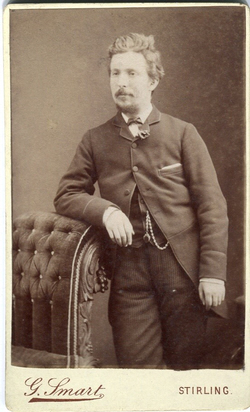 |
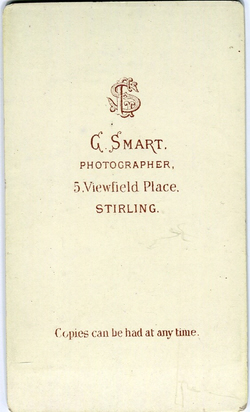 |
A carte de visite portrait of a man by George Smart, Stirling
Later that year George Smart took the wedding photographs when Charles and Maggie’s oldest daughter, Lillie, got married.
Tuesday 23rd October 1883: “Immediately after the [marriage] ceremony, we had two photographs taken outside the hall door, by Mr. Smart, who was in attendance.”
This was at the wedding of Charles and Maggie’s oldest daughter, Lillie. The wedding took place at Viewfield Lodge, Stirling.
27th November 1883: “Two dozen photographs of Lillie’s wedding party &c. came from Smart in the evening.”
Most of the diary entries for the end of 1883 refer to photographs of Charles’ daughter Lillie and son-in-law George and the wedding photos. The couple emigrated to North America and sent photos from there.
15th January 1884: “Heard from Lillie, from Minnedosa, on 28th Dec, after getting my first two letters there. [his first sent on 29th Nov] There were also letters from her of date Xmas eve to Charlie & Folie, with photos of Indians at Winnipeg, and a Minnedosa paper from George, with account of their arrival, and of a dinner he had given.”
12th March 1884: “Put up a pair of the photos of Lillie’s wedding party, and sent them off to Mary Jane to Canada. Edith, Charley & I had long letters from Lillie, from Winnipeg, also a photo of her and George done in New York.”
The entry below is for the day that Charles’ son Charlie was laid in his coffin. It is interesting to note that photos are involved in their sad farewell moments.
Saturday 4th October 1884: “Fine; cloudy. Arthur went to see Mr Coldwell, who called afterwards to see me; he arranged, as he was to be from home, that Mr Duthie should come on Tuesday for the service in the house here, at dear Charlie’s funeral. The coffin came in the evening for my dear boy: I held his dear head, and poor Lewie Hay [his cousin] his feet; dressed his dear face round with white flowers; placed a photo of his poor mother & one of myself over his heart with locks of our hair, wee sonnie’s, Edith’s & Foley’s. Kissed his dear cold brow, over & over again, & then he was hid away from our eyes forever. Before he was moved, cut off some of his hair. The coffin was lined with zinc, & soldered up inside. After Henderson left, we noticed that his name on the plate was spelt with an “S” instead of an “e” at the end of Johnstone. Heard from Mr C A Campbell.”
This is the last of the diary entries to mention photography.
~~~~~~~~~~~~~~~~~~~
The diary for just one of the years, 1884, runs to 42,000 words. The amount of effort involved in writing a diary means that we have so much to thank all of those people for who kept diaries in years gone by – especially Charles Johnstone!!
Acknowledgements
If any readers think they might be able to locate any of the photographs referred to in the diaries, James Robertson would be most interested to hear from you. He can be contacted at jamrobertson@gmail.com
This article would not have been possible without the enormous help from James who has provided all of the diary entries and the family background information. Thanks also to Jayne Shrimpton www.jayneshrimpton.co.uk, professional dress historian and author, who introduced James to me in the first instance.
Also thanks to Peter Stubbs for giving permission to reproduce three images from his excellent website www.edinphoto.org.uk
Ron Cosens Member No.1
February 2017
